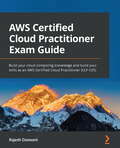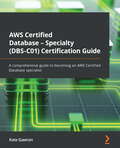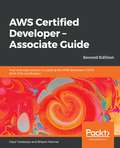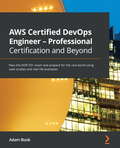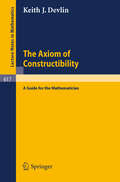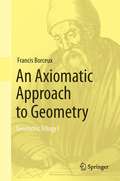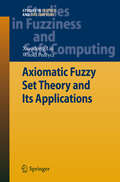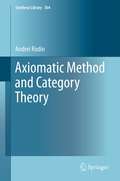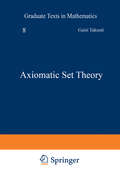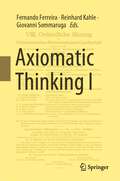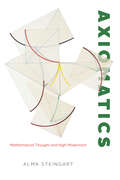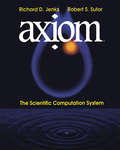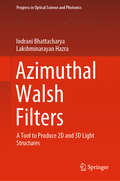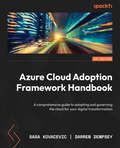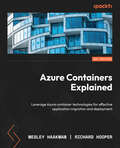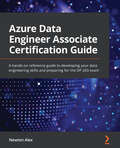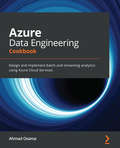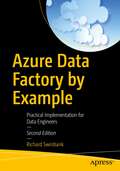- Table View
- List View
Aws Certified Cloud Practitioner Exam Guide: Build Your Cloud Computing Knowledge And Upskill Yourself As An Aws Certified Cloud Practitioner (clf-c01)
by Rajesh DaswaniBuild your cloud computing knowledge and build your skills as an AWS Certified Cloud Practitioner (CLF-C01)
Aws Certified Database - Specialty (dbs-c01) Certification Guide: A Comprehensive Guide To Becoming An Aws Certified Database Specialist (PDF)
by Kate GawronPass the AWS Certified Database- Specialty Certification exam with the help of practice tests Key Features Understand different AWS database technologies and when to use them Master the management and administration of AWS databases using both the console and command line Complete, up-to-date coverage of DBS-C01 exam objectives to pass it on the first attempt
AWS Certified Developer - Associate Guide, Second Edition: Your One-stop Solution To Passing The Aws Developer's 2019 (dva-c01) Certification, 2nd Edition
by Vipul TankariyaWith rapid adaptation of the cloud platform, the need for cloud certification has also increased. This is your one stop solution and will help you transform yourself from zero to certified. This guide will help you gain technical expertise in the AWS platform and help you start working with various AWS Services.
Aws Certified Devops Engineer - Professional Certification And Beyond: Pass The Dop-c01 Exam And Prepare For The Real World Using Case Studies And Real-life Examples
by Adam BookPass the DOP-C01 exam and prepare for the real world using case studies and real-life examples
Axiom of Choice (Lecture Notes in Mathematics #1876)
by Horst HerrlichAC, the axiom of choice, because of its non-constructive character, is the most controversial mathematical axiom. It is shunned by some, used indiscriminately by others. This treatise shows paradigmatically that disasters happen without AC and they happen with AC. Illuminating examples are drawn from diverse areas of mathematics, particularly from general topology, but also from algebra, order theory, elementary analysis, measure theory, game theory, and graph theory.
The Axiom of Constructibility: A Guide for the Mathematician (Lecture Notes in Mathematics #617)
by K. J. DevlinAn Axiomatic Approach to Geometry: Geometric Trilogy I
by Francis BorceuxFocusing methodologically on those historical aspects that are relevant to supporting intuition in axiomatic approaches to geometry, the book develops systematic and modern approaches to the three core aspects of axiomatic geometry: Euclidean, non-Euclidean and projective. Historically, axiomatic geometry marks the origin of formalized mathematical activity. It is in this discipline that most historically famous problems can be found, the solutions of which have led to various presently very active domains of research, especially in algebra. The recognition of the coherence of two-by-two contradictory axiomatic systems for geometry (like one single parallel, no parallel at all, several parallels) has led to the emergence of mathematical theories based on an arbitrary system of axioms, an essential feature of contemporary mathematics.This is a fascinating book for all those who teach or study axiomatic geometry, and who are interested in the history of geometry or who want to see a complete proof of one of the famous problems encountered, but not solved, during their studies: circle squaring, duplication of the cube, trisection of the angle, construction of regular polygons, construction of models of non-Euclidean geometries, etc. It also provides hundreds of figures that support intuition.Through 35 centuries of the history of geometry, discover the birth and follow the evolution of those innovative ideas that allowed humankind to develop so many aspects of contemporary mathematics. Understand the various levels of rigor which successively established themselves through the centuries. Be amazed, as mathematicians of the 19th century were, when observing that both an axiom and its contradiction can be chosen as a valid basis for developing a mathematical theory. Pass through the door of this incredible world of axiomatic mathematical theories!
Axiomatic, Enriched and Motivic Homotopy Theory: Proceedings of the NATO Advanced Study Institute on Axiomatic, Enriched and Motivic Homotopy Theory Cambridge, United Kingdom 9–20 September 2002 (NATO Science Series II: Mathematics, Physics and Chemistry #131)
by John GreenleesThe NATO Advanced Study Institute "Axiomatic, enriched and rna tivic homotopy theory" took place at the Isaac Newton Institute of Mathematical Sciences, Cambridge, England during 9-20 September 2002. The Directors were J.P.C.Greenlees and I.Zhukov; the other or ganizers were P.G.Goerss, F.Morel, J.F.Jardine and V.P.Snaith. The title describes the content well, and both the event and the contents of the present volume reflect recent remarkable successes in model categor ies, structured ring spectra and homotopy theory of algebraic geometry. The ASI took the form of a series of 15 minicourses and a few extra lectures, and was designed to provide background, and to bring the par ticipants up to date with developments. The present volume is based on a number of the lectures given during the workshop. The ASI was the opening workshop of the four month programme "New Contexts for Stable Homotopy Theory" which explored several themes in greater depth. I am grateful to the Isaac Newton Institute for providing such an ideal venue, the NATO Science Committee for their funding, and to all the speakers at the conference, whether or not they were able to contribute to the present volume. All contributions were refereed, and I thank the authors and referees for their efforts to fit in with the tight schedule. Finally, I would like to thank my coorganizers and all the staff at the Institute for making the ASI run so smoothly. J.P.C.GREENLEES.
Axiomatic Fuzzy Set Theory and Its Applications (Studies in Fuzziness and Soft Computing #244)
by Xiaodong Liu Witold PedryczIt is well known that “fuzziness”—informationgranulesand fuzzy sets as one of its formal manifestations— is one of important characteristics of human cognitionandcomprehensionofreality. Fuzzy phenomena existinnature and are encountered quite vividly within human society. The notion of a fuzzy set has been introduced by L. A. , Zadeh in 1965 in order to formalize human concepts, in connection with the representation of human natural language and computing with words. Fuzzy sets and fuzzy logic are used for mod- ing imprecise modes of reasoning that play a pivotal role in the remarkable human abilities to make rational decisions in an environment a?ected by - certainty and imprecision. A growing number of applications of fuzzy sets originated from the “empirical-semantic” approach. From this perspective, we were focused on some practical interpretations of fuzzy sets rather than being oriented towards investigations of the underlying mathematical str- tures of fuzzy sets themselves. For instance, in the context of control theory where fuzzy sets have played an interesting and practically relevant function, the practical facet of fuzzy sets has been stressed quite signi?cantly. However, fuzzy sets can be sought as an abstract concept with all formal underpinnings stemming from this more formal perspective. In the context of applications, it is worth underlying that membership functions do not convey the same meaning at the operational level when being cast in various contexts.
Axiomatic Method and Category Theory (Synthese Library #364)
by Andrei RodinThis volume explores the many different meanings of the notion of the axiomatic method, offering an insightful historical and philosophical discussion about how these notions changed over the millennia. The author, a well-known philosopher and historian of mathematics, first examines Euclid, who is considered the father of the axiomatic method, before moving onto Hilbert and Lawvere. He then presents a deep textual analysis of each writer and describes how their ideas are different and even how their ideas progressed over time. Next, the book explores category theory and details how it has revolutionized the notion of the axiomatic method. It considers the question of identity/equality in mathematics as well as examines the received theories of mathematical structuralism. In the end, Rodin presents a hypothetical New Axiomatic Method, which establishes closer relationships between mathematics and physics.Lawvere's axiomatization of topos theory and Voevodsky's axiomatization of higher homotopy theory exemplify a new way of axiomatic theory building, which goes beyond the classical Hilbert-style Axiomatic Method. The new notion of Axiomatic Method that emerges in categorical logic opens new possibilities for using this method in physics and other natural sciences.This volume offers readers a coherent look at the past, present and anticipated future of the Axiomatic Method.
Axiomatic Set Theory (Graduate Texts in Mathematics #8)
by G. Takeuti W.M. ZaringThis text deals with three basic techniques for constructing models of Zermelo-Fraenkel set theory: relative constructibility, Cohen's forcing, and Scott-Solovay's method of Boolean valued models. Our main concern will be the development of a unified theory that encompasses these techniques in one comprehensive framework. Consequently we will focus on certain funda mental and intrinsic relations between these methods of model construction. Extensive applications will not be treated here. This text is a continuation of our book, "I ntroduction to Axiomatic Set Theory," Springer-Verlag, 1971; indeed the two texts were originally planned as a single volume. The content of this volume is essentially that of a course taught by the first author at the University of Illinois in the spring of 1969. From the first author's lectures, a first draft was prepared by Klaus Gloede with the assistance of Donald Pelletier and the second author. This draft was then rcvised by the first author assisted by Hisao Tanaka. The introductory material was prepared by the second author who was also responsible for the general style of exposition throughout the text. We have inc1uded in the introductory material al1 the results from Boolean algebra and topology that we need. When notation from our first volume is introduced, it is accompanied with a deflnition, usually in a footnote. Consequently a reader who is familiar with elementary set theory will find this text quite self-contained.
Axiomatic Thinking I
by Fernando Ferreira Reinhard Kahle Giovanni SommarugaIn this two-volume compilation of articles, leading researchers reevaluate the success of Hilbert's axiomatic method, which not only laid the foundations for our understanding of modern mathematics, but also found applications in physics, computer science and elsewhere.The title takes its name from David Hilbert's seminal talk Axiomatisches Denken, given at a meeting of the Swiss Mathematical Society in Zurich in 1917. This marked the beginning of Hilbert's return to his foundational studies, which ultimately resulted in the establishment of proof theory as a new branch in the emerging field of mathematical logic. Hilbert also used the opportunity to bring Paul Bernays back to Göttingen as his main collaborator in foundational studies in the years to come.The contributions are addressed to mathematical and philosophical logicians, but also to philosophers of science as well as physicists and computer scientists with an interest in foundations.Chapter 8 is available open access under a Creative Commons Attribution 4.0 International License via link.springer.com.
Axiomatics: Mathematical Thought and High Modernism
by Alma SteingartThe first history of postwar mathematics, offering a new interpretation of the rise of abstraction and axiomatics in the twentieth century. Why did abstraction dominate American art, social science, and natural science in the mid-twentieth century? Why, despite opposition, did abstraction and theoretical knowledge flourish across a diverse set of intellectual pursuits during the Cold War? In recovering the centrality of abstraction across a range of modernist projects in the United States, Alma Steingart brings mathematics back into the conversation about midcentury American intellectual thought. The expansion of mathematics in the aftermath of World War II, she demonstrates, was characterized by two opposing tendencies: research in pure mathematics became increasingly abstract and rarified, while research in applied mathematics and mathematical applications grew in prominence as new fields like operations research and game theory brought mathematical knowledge to bear on more domains of knowledge. Both were predicated on the same abstractionist conception of mathematics and were rooted in the same approach: modern axiomatics. For American mathematicians, the humanities and the sciences did not compete with one another, but instead were two complementary sides of the same epistemological commitment. Steingart further reveals how this mathematical epistemology influenced the sciences and humanities, particularly the postwar social sciences. As mathematics changed, so did the meaning of mathematization. Axiomatics focuses on American mathematicians during a transformative time, following a series of controversies among mathematicians about the nature of mathematics as a field of study and as a body of knowledge. The ensuing debates offer a window onto the postwar development of mathematics band Cold War epistemology writ large. As Steingart’s history ably demonstrates, mathematics is the social activity in which styles of truth—here, abstraction—become synonymous with ways of knowing.
Axiomatics: Mathematical Thought and High Modernism
by Alma SteingartThe first history of postwar mathematics, offering a new interpretation of the rise of abstraction and axiomatics in the twentieth century. Why did abstraction dominate American art, social science, and natural science in the mid-twentieth century? Why, despite opposition, did abstraction and theoretical knowledge flourish across a diverse set of intellectual pursuits during the Cold War? In recovering the centrality of abstraction across a range of modernist projects in the United States, Alma Steingart brings mathematics back into the conversation about midcentury American intellectual thought. The expansion of mathematics in the aftermath of World War II, she demonstrates, was characterized by two opposing tendencies: research in pure mathematics became increasingly abstract and rarified, while research in applied mathematics and mathematical applications grew in prominence as new fields like operations research and game theory brought mathematical knowledge to bear on more domains of knowledge. Both were predicated on the same abstractionist conception of mathematics and were rooted in the same approach: modern axiomatics. For American mathematicians, the humanities and the sciences did not compete with one another, but instead were two complementary sides of the same epistemological commitment. Steingart further reveals how this mathematical epistemology influenced the sciences and humanities, particularly the postwar social sciences. As mathematics changed, so did the meaning of mathematization. Axiomatics focuses on American mathematicians during a transformative time, following a series of controversies among mathematicians about the nature of mathematics as a field of study and as a body of knowledge. The ensuing debates offer a window onto the postwar development of mathematics band Cold War epistemology writ large. As Steingart’s history ably demonstrates, mathematics is the social activity in which styles of truth—here, abstraction—become synonymous with ways of knowing.
axịom™: The Scientific Computation System
by Richard D. Jenks Robert S. SutorRecent advances in hardware performance and software technology have made possible a wholly different approach to computational mathematics. Symbolic computation systems have revolutionized the field, building upon established and recent mathematical theory to open new possibilities in virtually every industry. Formerly dubbed Scratchpad, AXIOM is a powerful new symbolic and numerical system developed at the IBM Thomas J. Watson Research Center. AXIOM's scope, structure, and organization make it outstanding among computer algebra systems. AXIOM: The Scientific Computation System is a companion to the AXIOM system. The text is written in a straightforward style and begins with a spirited foreword by David and Gregory Chudnovsky. The book gives the reader a technical introduction to AXIOM, interacts with the system's tutorial, accesses algorithms newly developed by the symbolic computation community, and presents advanced programming and problem solving techniques. Eighty illustrations and eight pages of color inserts accompany text detailing methods used in the 2D and 3D interactive graphics system, and over 2500 example input lines help the reader solve formerly intractable problems.
Ay's Neuroanatomy of C. Elegans for Computation (Routledge Revivals)
by Theodore B. Achacoso William S. YamamotoFirst published in 1992, AY's Neuroanatomy of C. elegans for Computation provides the neural circuitry database of the nematode Caenorhabditis elegans, both in printed form and in ASCII files on 5.25-inch diskettes (for use on IBM® and compatible personal computers, Macintosh® computers, and higher level machines). Tables of connections among neuron classes, synapses among individual neurons, gap junctions among neurons, worm cells and their embryonic origin, and synthetically derived neuromuscular connections are presented together with the references from which the data were compiled and edited. Sample data files and source codes of FORTRAN and BASIC programs are provided to illustrate the use of mathematical tools for any researcher or student interested in examining a natural neural network and discovering what makes it tick.
Ay's Neuroanatomy of C. Elegans for Computation (Routledge Revivals)
by Theodore B. Achacoso William S. YamamotoFirst published in 1992, AY's Neuroanatomy of C. elegans for Computation provides the neural circuitry database of the nematode Caenorhabditis elegans, both in printed form and in ASCII files on 5.25-inch diskettes (for use on IBM® and compatible personal computers, Macintosh® computers, and higher level machines). Tables of connections among neuron classes, synapses among individual neurons, gap junctions among neurons, worm cells and their embryonic origin, and synthetically derived neuromuscular connections are presented together with the references from which the data were compiled and edited. Sample data files and source codes of FORTRAN and BASIC programs are provided to illustrate the use of mathematical tools for any researcher or student interested in examining a natural neural network and discovering what makes it tick.
Azimuthal Walsh Filters: A Tool to Produce 2D and 3D Light Structures (Progress in Optical Science and Photonics #10)
by Indrani Bhattacharya Lakshminarayan HazraThis book explores the possibility of using azimuthal Walsh filters as an effective tool for manipulating far-field diffraction characteristics near the focal plane of rotationally symmetric imaging systems. It discusses the generation and synthesis of azimuthal Walsh filters, and explores the inherent self-similarity presented in various orders of these filters, classifying them into self-similar groups and sub-groups. Further, it demonstrates that azimuthal Walsh filters possess a unique rotational self-similarity exhibited among adjacent orders. Serving as an atlas of diffraction phenomena with pupil functions represented by azimuthal Walsh filters of different orders, this book describes how orthogonality and self-similarity of these filters could be harnessed to sculpture 2D and 3D light distributions near the focus.
Azure Cloud Adoption Framework Handbook: A Comprehensive Guide To Adopting And Governing The Cloud For Your Digital Transformation
by Sasa Kovacevic Darren DempseyA comprehensive guide to adopting and governing the cloud for your digital transformation
Azure Containers Explained: Leverage Azure Container Technologies For Effective Application Migration And Deployment
by Wesley Haakman and Richard HooperLeverage Azure container technologies for effective application migration and deployment
Azure Data Engineer Associate Certification Guide: A Hands-on Reference Guide To Developing Your Data Engineering Skills And Preparing For The Dp-203 Exam (pdf)
by Newton AlexBecome well-versed with data engineering concepts and exam objectives to achieve Azure Data Engineer Associate certification Key Features Understand and apply data engineering concepts to real-world problems and prepare for the DP-203 certification exam Explore the various Azure services for building end-to-end data solutions Gain a solid understanding of building secure and sustainable data solutions using Azure services Book Description Azure is one of the leading cloud providers in the world, providing numerous services for data hosting and data processing. Most of the companies today are either cloud-native or are migrating to the cloud much faster than ever. This has led to an explosion of data engineering jobs, with aspiring and experienced data engineers trying to outshine each other. Gaining the DP-203: Azure Data Engineer Associate certification is a sure-fire way of showing future employers that you have what it takes to become an Azure Data Engineer. This book will help you prepare for the DP-203 examination in a structured way, covering all the topics specified in the syllabus with detailed explanations and exam tips. The book starts by covering the fundamentals of Azure, and then takes the example of a hypothetical company and walks you through the various stages of building data engineering solutions. Throughout the chapters, you'll learn about the various Azure components involved in building the data systems and will explore them using a wide range of real-world use cases. Finally, you'll work on sample questions and answers to familiarize yourself with the pattern of the exam. By the end of this Azure book, you'll have gained the confidence you need to pass the DP-203 exam with ease and land your dream job in data engineering. What you will learn Gain intermediate-level knowledge of Azure the data infrastructure Design and implement data lake solutions with batch and stream pipelines Identify the partition strategies available in Azure storage technologies Implement different table geometries in Azure Synapse Analytics Use the transformations available in T-SQL, Spark, and Azure Data Factory Use Azure Databricks or Synapse Spark to process data using Notebooks Design security using RBAC, ACL, encryption, data masking, and more Monitor and optimize data pipelines with debugging tips Who this book is for This book is for data engineers who want to take the DP-203: Azure Data Engineer Associate exam and are looking to gain in-depth knowledge of the Azure cloud stack. The book will also help engineers and product managers who are new to Azure or interviewing with companies working on Azure technologies, to get hands-on experience of Azure data technologies. A basic understanding of cloud technologies, extract, transform, and load (ETL), and databases will help you get the most out of this book. Table of Contents Introducing Azure Basics Designing a Data Storage Structure Designing a Partition Strategy Designing the Serving Layer Implementing Physical Data Storage Structures Implementing Logical Data Structures Implementing the Serving Layer Ingesting and Transforming Data Designing and Developing a Batch Processing Solution Designing and Developing a Stream Processing Solution Managing Batches and Pipelines Designing Security for Data Policies and Standards Monitoring Data Storage and Data Processing Optimizing and Troubleshooting Data Storage and Data Processing Sample Questions with Solutions
Azure Data Engineer Associate Certification Guide, Second Edition: Ace The Dp-203 Exam With Advanced Data Engineering Skills
by Giacinto Palmieri, Surendra Mettapalli, and Newton AlexAce the DP-203 exam with advanced data engineering skills
Azure Data Engineering Cookbook: Design And Implement Batch And Streaming Analytics Using Azure Cloud Services
by Ahmad OsamaDesign and implement batch and streaming analytics using Azure Cloud Services
